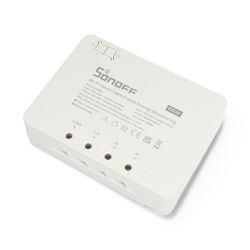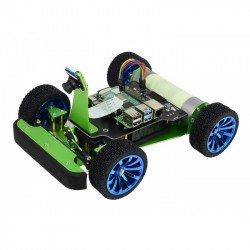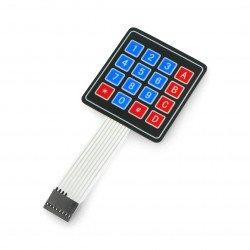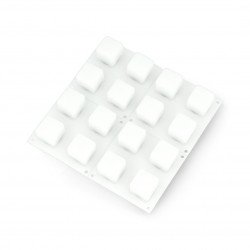- New
- Reduced price
- Pack
- Sale
Klawiatury membranowe 4x4
Self-adhesive membrane keyboard 4x4 - 16 keys
Diaphragm keypad equipped with 16 keys in 4 x 4 arrangement . It has numbers: from 0 to 9, letters: A, B, C, D and special characters: * i #. On the back of the keyboard there...Silicone Elastomer 4x4 keyboard overlay - Adafruit 1611
Made of flexible silicone keyboard overlay from Adafruit. It consists of 16 buttons in a 4x4 arrangement. An LED can be mounted under each button in a 3mm scroll...Panel for 4x4 keyboard - compatible with LED diodes - SparkFun COM-07835
Keyboard overlay with 4x4 - 16 keys. Under each key, an LED can be mounted in a 3 or 5 mm threaded housing. This allows you to create a backlit key panel.- Sale
- SPECIAL OFFERS
NeoTrellis RGB Driver PCB - 4x4 keyboard with backlit keys - Adafruit 3954
NeoTrellis RGB Driver PCB keyboard with 16 buttons arranged in 4 columns by 4 rows. Each button is illuminated with a separate RGB LED, so the keys can glow in different...Keyboard 4 x 4 - operation and applications
The 4 x 4 keyboard is one of the most popular varieties of numeric keypad. It is equipped with sixteen buttons - digits from 0 to 9, letters A, B, C and D and special characters * and #. Each of the keys is assigned an action, and additionally the device can be programmed to react not only to single key presses, but also to their different combinations. This gives great possibilities, that is why the 4 x 4 keyboard is commonly used in many electronic projects and devices. It can be found, among others, in security systems (intercoms, code locks, PIN deactivated alarms), cash registers, payment terminals, microwaves, phones, calculators and many other places. You can also conveniently control physical or on-screen movement using this keypad - compared to, for example, keys, arrows, the numerical panel gives you more possibilities and allows for customized movements such as following in diagonal directions with a single button.
Choosing a 4 x 4 keyboard for your project
When choosing a model for a specific project, several factors should be taken into account. If you are going to connect the keyboard to a microcontroller, a single-platform computer or other central system, you need to check if they are compatible - including the number of outputs needed to connect the voltage and current, power supply or the interface through which you will program. For example, when looking for a 4 x 4 keyboard for Arduino, it is best to choose a model that communicates through the analog output, because the board will work well with it. In projects using Raspberry Pi you should rather use a digital keyboard. If you plan to customize the keys or highlight them, a convenient solution will be to buy a module with sixteen tact switch buttons, on which you will then place an overlay with appropriate symbols. And don't forget to choose a model of the keyboard for the conditions in which you will use the device - if your equipment may be exposed to the presence of moisture, dust or sudden changes in temperature, it is better to choose a model equipped with appropriate protection to protect it from damage.
What 4 x 4 keyboards can you find in our shop?
In our assortment you will find, among others, classic 4 x 4 keyboards made in membrane technology. They are comfortable to use, take up little space and can be easily mounted in the desired position using the adhesive tape on the back. They can be connected to the board using a goldpin strip or suitable connection cables. We also offer touch-sensitive keyboards, for example, a model equipped with TTP229 and communicating via a digital interface. In our shop there are also matrices with tact switch type buttons, which are designed for independent housing, marking and programming of individual functions (matrices are available in analogue and digital versions). Useful accessories for this type of products are rubber caps, which can be easily illuminated or marked at will. Another proposal is printed circuit boards, on which you can install the buttons yourself.


















































































































































































































































































































































